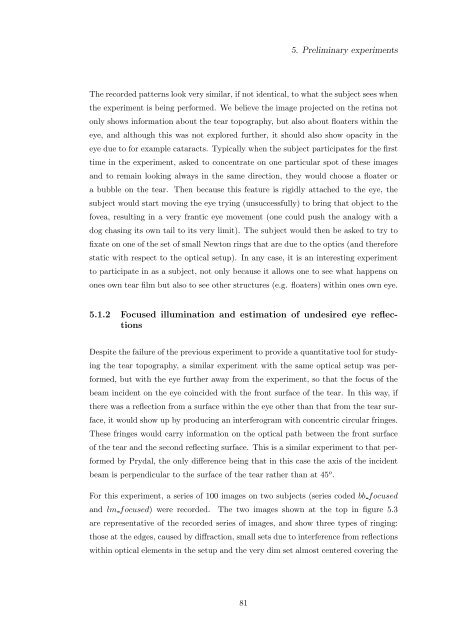Alfredo Dubra's PhD thesis - Imperial College London
Alfredo Dubra's PhD thesis - Imperial College London
Alfredo Dubra's PhD thesis - Imperial College London
You also want an ePaper? Increase the reach of your titles
YUMPU automatically turns print PDFs into web optimized ePapers that Google loves.
5. Preliminary experiments<br />
The recorded patterns look very similar, if not identical, to what the subject sees when<br />
the experiment is being performed. We believe the image projected on the retina not<br />
only shows information about the tear topography, but also about floaters within the<br />
eye, and although this was not explored further, it should also show opacity in the<br />
eye due to for example cataracts. Typically when the subject participates for the first<br />
time in the experiment, asked to concentrate on one particular spot of these images<br />
and to remain looking always in the same direction, they would choose a floater or<br />
a bubble on the tear. Then because this feature is rigidly attached to the eye, the<br />
subject would start moving the eye trying (unsuccessfully) to bring that object to the<br />
fovea, resulting in a very frantic eye movement (one could push the analogy with a<br />
dog chasing its own tail to its very limit). The subject would then be asked to try to<br />
fixate on one of the set of small Newton rings that are due to the optics (and therefore<br />
static with respect to the optical setup). In any case, it is an interesting experiment<br />
to participate in as a subject, not only because it allows one to see what happens on<br />
ones own tear film but also to see other structures (e.g. floaters) within ones own eye.<br />
5.1.2 Focused illumination and estimation of undesired eye reflections<br />
Despite the failure of the previous experiment to provide a quantitative tool for studying<br />
the tear topography, a similar experiment with the same optical setup was performed,<br />
but with the eye further away from the experiment, so that the focus of the<br />
beam incident on the eye coincided with the front surface of the tear. In this way, if<br />
there was a reflection from a surface within the eye other than that from the tear surface,<br />
it would show up by producing an interferogram with concentric circular fringes.<br />
These fringes would carry information on the optical path between the front surface<br />
of the tear and the second reflecting surface. This is a similar experiment to that performed<br />
by Prydal, the only difference being that in this case the axis of the incident<br />
beam is perpendicular to the surface of the tear rather than at 45 o .<br />
For this experiment, a series of 100 images on two subjects (series coded bb focused<br />
and lm focused) were recorded. The two images shown at the top in figure 5.3<br />
are representative of the recorded series of images, and show three types of ringing:<br />
those at the edges, caused by diffraction, small sets due to interference from reflections<br />
within optical elements in the setup and the very dim set almost centered covering the<br />
81

















